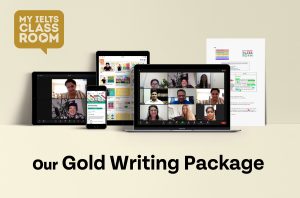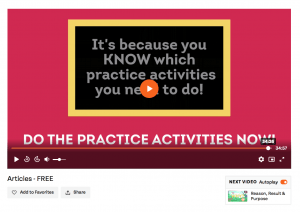
Can watching IELTS videos really help you learn?
Never before have IELTS students had so much free material to learn from. But is having so many free IELTS videos, really helping students to prepare for the test in the best way or could they actually be having a detrimental effect on some students’ preparation? Today, Nick and I discuss the dangers of watching IELTS videos and give clear advice about how to make the most of online content.
This lesson was inspired by a recent episode of Hidden Brain. We will play short extracts throughout the lesson, but you can listen to the full version here (with a transcript.

Below, you can find a summary of the episode, which includes all of the links to useful materials and the times of each part of the discussion (so you can go directly to the part you want to listen to) 🚀
- Subscribe to My IELTS Classroom podcast on Apple podcasts here
- Subscribe to My IELTS Classroom on Google podcasts here
- Become a Patreon to gain access to extra BONUS episodes here

Can watching IELTS videos really help you learn?
Last week, I bought a new coffee machine. It was not the most expensive purchase I have ever made in my life, but it certainly cost enough for me to think about making the purchase for several days and to feel a bit guilty when I finally hit “Buy”. I have never been very good at treating myself to material goods, but I drink two cups of coffee every day and I have always daydreamed of being able to make a good quality cappuccino in my own home.
What really convinced me to make the purchase, though, were the 40 or 50 YouTube videos I had watched over the last month. I started at “Best espresso machines under $100” in September, and by the end of October, I had learned how to “dial-in” espressos from a former World Champion barista and how to froth milk from a Latte Artist. In other words, I was 100% confident that when my machine arrived, I would be able to make mind-glowingly good coffee from the first cup.
Sadly, this was not the case.
Even though I had watched dozens of videos about the correct angle to hold my milk jug when frothing to create a nice thick foam and how small to grind the beans to get a perfect shot, what I did in my kitchen that day was nothing short of a disaster. After two hours all I had was milk in my hair and coffee grinds all over the kitchen. By all accounts, making good espresso was much more difficult that in seemed.
This got me to thinking – is this what is happening to my students when they follow my video course? Are they following along the lessons at home, thinking that they are improving, but then coming in for a nasty shock when they sit their exams? After all, surely writing an essay is not so different to making a cup of coffee – you just need the right equipment and to follow the correct steps. What can I learn from my experience making a cappuccino will help my students avoiding a similar disaster in their IELTS exam?
If you are looking for the highest level of support and guidance in your IELTS journey, then why not find out about our award-wining Gold Package by clicking here.

The first problem with IELTS videos: Overconfidence
The first thing I was reminded of was an episode of Hidden Brain that I had listened to a couple of months ago. It solidified for me something that I had thought might be happening but I wasn’t 100% sure – that IELTS videos were giving students a false confidence in their ability. Or, rather, that there were many students today who were spending all of their IELTS preparation watching videos, and that this was giving them a false impression about their own expertise.
Now, I want to be clear, I run an online English school whose main method of teaching used to be only video content, so I obviously think that video lessons can be a great resource. However, what I had noticed is that there was a growing number of students who were almost exclusively watching video content and nothing else. The result was that they were all very good at “talking the talk” – they all had the “language” of IELTS and knew what was expected of them in the exam – but very few were actually able to “walk the walk” – they were unable to put that knowledge into action by writing good essays.
These were students who would email me with really detailed questions – I mean very specific questions about small parts of particular essays. Questions like:
Can I add a balancing sentence to the first paragraph of a discuss both sides essay ? or
Can I use 3rd conditional inversion in my essays?
Almost always, these questions come from a student who is stuck at a 6.5 and who has many other much more basic problems with their essays.
- They can’t generate relevant ideas.
- They over-paraphrase.
- They are missing topic sentences.
- They cannot write a paragraph that progresses.
- They make dozens of grammar mistakes.
However, it never occurs to the student that these more foundational skills are the reason for their current score. Why?
Because they are overconfident that they can do these basic things well.
I mean, they know that these are the things that they have to do, so how on earth can they be the problem? Well, as my coffee machine disaster shows, there is a big difference between knowing and doing.
This is what some of the experiments described in Hidden Brain episode confirmed. It seems that unlike when reading an instruction manual, when watching how-to videos gives viewers a false sense of confidence in their ability to be able to perform a skill. In the episode, they describe how a group of people who had repeatedly watched a video outlining how to pull a tablecloth from a table without disturbing the cups and plates on top of it all believed that they could do it on a first attempt, even though it is obviously an incredibly difficult task and one which they have no hope of completing. In contrast, the group who had read a book about the trick had no such illusions – they understood it was impossible.

It seems then that watching videos has the unique consequence of making us feel confident in our ability to complete a task, even if logically that confidence makes no sense. No wonder so many students are surprised when they sit the exam and get a score that is lower than expected!
The second problem with IELTS videos: They stop you actually practising
The other problem with having so much free online content is that people can spend all day every day watching lessons without ever once stopping and trying to put into practice what they have learned. I understand that students feel like there is a lot to learn, and so the temptation is definitely there to try to watch lesson after lesson to gather as much information a possible.
However, as we have just noted, there is a huge difference between logically understanding what you have been told and being able to put that information into practice.
I can “teach” you the rules of articles, for example, in about 30 minutes but it may take you a lifetime to be able to apply those rules correctly. Herein lies the problem – while watching video content may give confidence that you can carry out a task, you will not actually gain the ability to really do it unless you practice.
Too often students come to me eager to learn, and show that eagerness by saying “I can watch 10 videos a day”. This always a warning sign that the student does not know how to self-study properly.
Firstly, what I have in my course are not “IELTS videos” but interactive “IELTS lessons”. If you think that you can join my classroom and watch a lesson while eating your dinner or driving to work, think again. I will ask you at least twice in every lesson to pause and participate That might be to complete some grammar activities, come up with ideas, or to logically organise a paragraph.
However, no matter what I ask you to do, it is ALWAYS the students who do pause and participate who progress most quickly. After all, that is the time when your brain has the chance to use the information that I have given and, thus, solidify it in your memory.

In the same way, at the end of every lesson I tell the students to “Go and do the practice activities”. I made sure that I did that at the end of EVERY video, even though I knew that it might become boring or annoying for the student to hear it every time. Why?
Because I know that as humans we all want to skip the part when we have to do something because it is difficult and time-consuming, but that is the step that helps us to learn most.
This is what concerns me most about IELTS videos – they are easy to watch and so make up the majority of a student’s preparation. However, if you are spending 90% of your time watching lessons and 10% practising, you should consider reversing that. You learn by doing not watching, so the majority of your time should be spent building your own skills rather than watching somebody else.
The third problem with IELTS videos: The experts make it look easy
This is the third problem with IELTS videos – they give you a false impression of how difficult it is to write a good essay or to answer a difficult reading question. Remember, if you are learning from a native speaker, then they will have no problem with grammar or lexis when they show you how to write or listen or read. In the same way, native and non-native speaker teachers plan their IELTS videos in advance so whenever they write or give a model answer, what you are seeing has been thoroughly thought out and all of the “mistakes” edited out.
Even Nick and I have sometimes decided to leave out a particular essay question from a podcast episode as it was too difficult to come up with clear ideas!
My point is that IELTS is not always as easy as content creators may make it seem, and often even good teachers can skim over the complexity of certain questions in an attempt to make the questions seem straightforward (and themselves look good!).
The consequence of this is not only that students may falsely believe the exam is easier than it really is, but also that they may feel frustrated when they are not able to come up with idea or solutions as quickly as the tutors in the videos. One of the major obstacles I see facing students today is their belief that they “should be able to pass quickly” or that “the exam isn’t really that difficult”. Then, when they cannot reach their target scores quickly, they can become dejected or depressed. I strongly believe that IELTS videos that claim to make everything “quick and easy” are to blame for this.
What is the right way to use IELTS videos?
So, what are we to make then of IELTS videos? Well, I would say the main thing to remember is that IELTS videos can definitely teach you something, but they cannot teach you everything. They should be used as a tool to gather information and knowledge of english and academic skills, but YOU HAVE TO TRY to do the things demonstrated in the videos yourself to give your brain a chance to really master the skills.
If you are on one of my IELTS courses, you don’t need to worry about this. You can just do the practice activities at the end of each lesson or come and take part in our daily live lessons and you will be given ample opportunity to put what you have been taught into practice.
However, if you are self-studying, you should create these opportunities for yourself. Every time you finish watching an IELTS video, set yourself the challenge of actually using the information you have just been given in a practical way.
- Just watched a video about writing introductions to task one? Then go and write three introductions!
- Just learned how to tackle Headings Match questions? Then go and do one from a Cambridge book before watching the next video!
- Just learned how to use the 1 minute preparation time before Speaking Part 2? Then time yourself planning and record your answer.
There is always going to be a gap between what you think that you can do and what you can actually do. Don’t be demotivated by that gap – try to close it! Note what you still find difficult to do after watching the lessons and then practice. You may find it takes a few weeks or even months, but if you are actively practising, you will have a far better chance of improving than if you just keep on watching more and more videos.
As for me, I have had my coffee machine a week now and I am already making progress on my cappuccinos. How? I switched off YouTube and switched on my machine.
That said, if you do want to take advantage of high quality lessons on YouTube, why not start with the lesson below!!!
